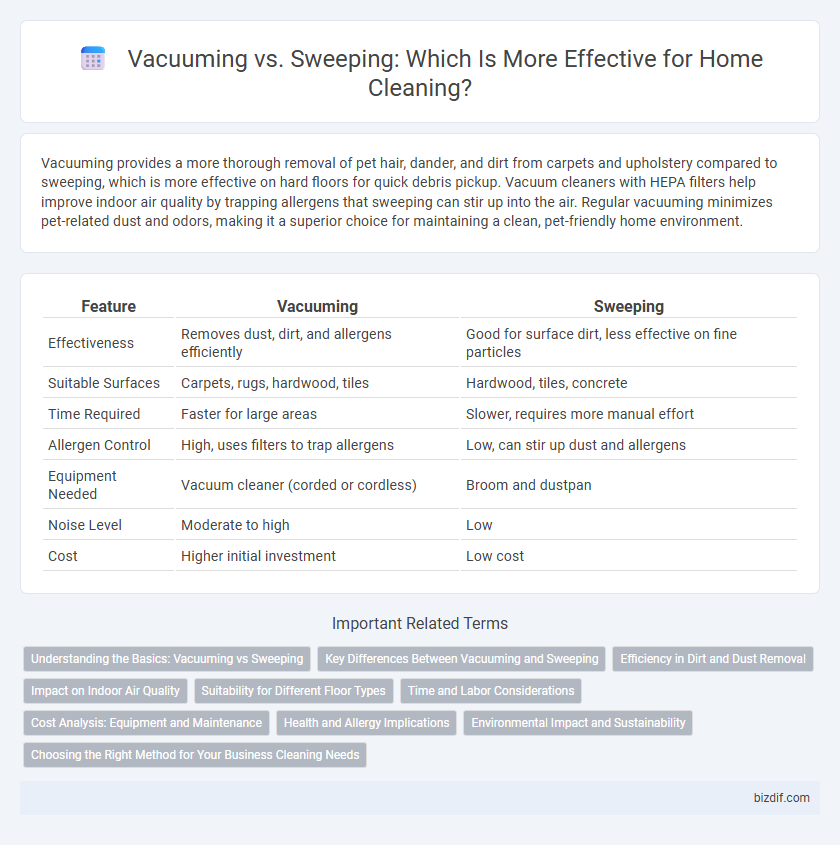Vacuuming provides a more thorough removal of pet hair, dander, and dirt from carpets and upholstery compared to sweeping, which is more effective on hard floors for quick debris pickup. Vacuum cleaners with HEPA filters help improve indoor air quality by trapping allergens that sweeping can stir up into the air. Regular vacuuming minimizes pet-related dust and odors, making it a superior choice for maintaining a clean, pet-friendly home environment.
Table of Comparison
| Feature | Vacuuming | Sweeping |
|---|---|---|
| Effectiveness | Removes dust, dirt, and allergens efficiently | Good for surface dirt, less effective on fine particles |
| Suitable Surfaces | Carpets, rugs, hardwood, tiles | Hardwood, tiles, concrete |
| Time Required | Faster for large areas | Slower, requires more manual effort |
| Allergen Control | High, uses filters to trap allergens | Low, can stir up dust and allergens |
| Equipment Needed | Vacuum cleaner (corded or cordless) | Broom and dustpan |
| Noise Level | Moderate to high | Low |
| Cost | Higher initial investment | Low cost |
Understanding the Basics: Vacuuming vs Sweeping
Vacuuming effectively removes dust, pet hair, and allergens from carpets and hard floors using powerful suction, making it ideal for deep cleaning. Sweeping is best suited for quickly gathering larger debris and dirt on hard surfaces like tile or hardwood, but it may leave behind fine particles. Choosing between vacuuming and sweeping depends on floor type and desired cleanliness level, with vacuuming offering a more thorough approach for comprehensive home cleaning.
Key Differences Between Vacuuming and Sweeping
Vacuuming uses suction technology to remove dust, dirt, and allergens from various floor surfaces including carpets, rugs, and hardwood, making it more effective for deep cleaning. Sweeping relies on a broom to manually gather dirt and debris primarily from hard floors, but it often leaves fine dust particles behind. Vacuuming also reduces allergens and improves indoor air quality more efficiently than sweeping, which tends to disperse dust into the air.
Efficiency in Dirt and Dust Removal
Vacuuming excels in efficiency by using powerful suction to remove fine dust, dirt, and allergens from carpets, rugs, and hard floors, reaching deep into fibers and cracks. Sweeping effectively handles larger debris on hard surfaces but often leaves behind microscopic particles that accumulate over time. For thorough dirt and dust removal, vacuuming provides a more comprehensive cleaning solution, especially in homes with pets or allergy sufferers.
Impact on Indoor Air Quality
Vacuuming with a high-efficiency particulate air (HEPA) filter significantly reduces indoor airborne allergens and dust mites compared to sweeping, which often stirs up dust particles into the air. Sweeping can worsen indoor air quality by dispersing fine dust and contaminants that settle on surfaces, while vacuuming traps these particles within the vacuum's filtration system. For optimal indoor air quality, using a vacuum cleaner equipped with advanced filters is essential to minimize airborne pollutants and promote healthier living environments.
Suitability for Different Floor Types
Vacuuming is highly effective for carpets and rugs, as it removes embedded dirt and allergens that sweeping cannot reach. Sweeping is more suitable for hard surfaces like hardwood, tile, and laminate, efficiently clearing dust and debris without scratching. Combining both methods ensures optimal cleanliness tailored to diverse floor materials.
Time and Labor Considerations
Vacuuming typically requires less physical effort and can clean more efficiently by simultaneously removing dust, debris, and allergens from carpets and hard floors, saving time compared to sweeping. Sweeping demands more repetitive motion and is less effective on textured surfaces, often extending cleaning duration and labor intensity. For large areas, vacuuming optimizes productivity by combining suction power with brush agitation, reducing overall cleaning time and fatigue.
Cost Analysis: Equipment and Maintenance
Vacuuming typically involves higher upfront equipment costs, ranging from $50 to $500 for quality models, plus ongoing maintenance expenses such as bag replacements, belt changes, and filter cleaning. Sweeping requires minimal investment, usually a one-time purchase of a broom costing between $10 and $30, with negligible maintenance costs. Over time, sweeping proves more cost-effective, while vacuuming offers enhanced efficiency and deeper cleaning capabilities.
Health and Allergy Implications
Vacuuming with a HEPA filter effectively captures dust mites, pet dander, and pollen, reducing airborne allergens and improving indoor air quality. Sweeping often disperses fine dust and allergens into the air, potentially exacerbating respiratory issues and allergies. Regular vacuuming is recommended for allergy sufferers to maintain a healthier home environment and minimize asthma triggers.
Environmental Impact and Sustainability
Vacuuming typically consumes electricity, contributing to carbon emissions depending on the energy source, whereas sweeping relies on manual effort and produces no direct emissions. Many modern vacuum cleaners feature HEPA filters that improve indoor air quality by capturing fine dust and allergens, aiding in sustainable living. Choosing tools with durable materials and energy-efficient designs minimizes environmental impact while maintaining effective home cleaning.
Choosing the Right Method for Your Business Cleaning Needs
Vacuuming efficiently removes dust, allergens, and fine particles from carpets and upholstery, making it ideal for businesses with high foot traffic and varied flooring types. Sweeping is cost-effective and quick for hard surfaces like tile or hardwood but may leave finer debris behind. Evaluate your business environment and surface materials to select a cleaning method that ensures thorough sanitation and maintains professional appearance.
Vacuuming vs Sweeping Infographic

 bizdif.com
bizdif.com